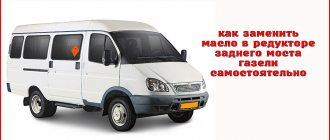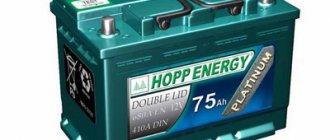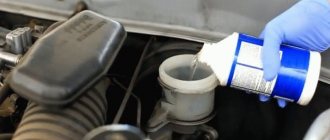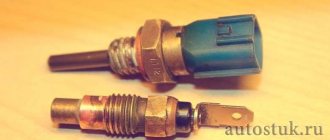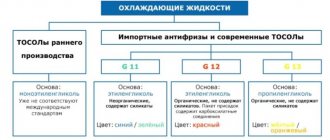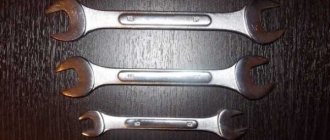You can determine which unit is installed on the selected brand of car without the help of the seller. To do this, you need to look under the hood of the car. If you find a tank there with a corresponding pictogram depicting a steering wheel, it means that in front of you is a car with power steering. It is into this tank that the power steering fluid is poured. If there is no reservoir, and the steering wheel turns freely, then this means that the car has an ESD installed.
Healthy! In some cars, the power steering fluid reservoir is located in the bumper and the device is a hybrid of electric and hydraulic power steering. But such cars can be counted on one hand. For example, several Opel Zafira models are equipped with just such “hidden” power steering units.
To figure out whether electric power steering or hydraulic power steering is better, it’s first worth talking about the features and differences of each of these systems separately.
Power steering
Power steering is more common today, unlike the electrical system, which is just gaining momentum. The hydraulic booster consists of complex components - low and high pressure pipelines, belts and other elements through which fluid circulates, poured into a special tank connected to pumping equipment. As soon as the driver turns the steering wheel, a number of processes occur. First, high-pressure fluid is supplied through the distributor into the steering mechanism, after which it is pumped into the hydraulic cylinder, thereby creating pressure that affects the piston. As a result of the displacement of the latter, the degree of effort that the driver applies to turn the steering wheel is reduced. When moving along a straight path, the power steering fluid flows back into the reservoir. As you can see, this is a rather complex closed fluid circulation system, in which many elements are involved, each of which can fail over time.
If we talk about the features of power steering, it is worth mentioning the following disadvantages:
- The hydraulic booster consumes engine energy, and as a result, engine power drops noticeably.
- The system is quite capricious and requires periodic maintenance (the power steering fluid should be replaced every 50,000-80,000 kilometers or as soon as its level in the reservoir drops to a minimum level). In addition, quite often you have to tighten the pump belt.
- A prerequisite for the proper functioning of the power steering is the complete tightness of the components.
- Temperature fluctuations have a detrimental effect on the power steering fluid, resulting in a decrease in the efficiency of the entire system as a whole.
In addition to these shortcomings, many car enthusiasts often complain that the power steering hums when turning. This problem may be due to a breakdown in the steering rack, problems with the pump, belt or poor quality oil. As a result of the fact that the system, designed to simplify the life of motorists, began to bring a lot of trouble, a simpler and more convenient mechanism was developed - an electric booster.
Electric power steering
The design of the electric power steering is much simpler than that of a hydraulic booster. By and large, this is a small electric motor, a control unit and two sensors: torque and angle of rotation. A device mounted on the steering rack or column itself reads information about which driver is transmitting the steering angle. In this case, torque is transmitted using a torsion shaft, which is built into the steering unit.
If we talk about how power steering differs from electric power steering, then in the first case, the force applied to the steering wheel is reduced due to pressure and circulating fluid, in the second, the information is converted thanks to electrics, as a result of which the wheels turn slightly. In this case, the electronic power steering unit analyzes the data and, based on it, calculates how much current the electric motor will require. Thanks to this, when parking or sharp maneuvers, the greatest effort is produced from the EUR. During slow turns, the electric power steering reduces torque and is practically not used.
We recommend: The best SUVs under 800 thousand rubles in 2019
If we talk about the advantages of electric power steering over power steering, then it is worth noting the following advantages of the electric amplifier:
- It takes up minimal space.
- During operation, the EUR consumes energy only at those moments when it is in use. The power steering works constantly as soon as you start the engine.
- The electric booster operates uninterruptedly both in severe frosts and in hot weather.
- Since the EUR consists of fewer elements, it is more reliable, since it does not require constant maintenance and repair.
However, electric boosters have their own characteristics that confuse some drivers. Therefore, let’s try to figure out which system performs better in management.
Characteristics of power steering
This type of amplifier appeared much earlier than the electric one. Power steering is a vehicle steering element that operates using a liquid drive. Despite the growing popularity of electric power steering (VAZ is also equipped with it), power steering is the most common amplifier. Structurally, this unit contains a hydraulic pump. It is driven by the crankshaft via a belt drive. The reader can see what it looks like in the photo below.
Below we will consider the algorithm of operation of this system.
Signs of power steering wear
Power steering is not only comfort, but also additional safety (especially if emergency steering is necessary in an emergency situation). Therefore, you should pay close attention to the first signs of a faulty power steering:
- Vibrations appeared on the steering wheel;
- The steering wheel began to turn with difficulty;
- After completing a turn, the steering wheel is in no hurry to return to “zero”;
- The power steering pump hums when the steering wheel is turned;
- Fogging (traces of oil) on the power steering reservoir;
- Traces of hydraulic oil after parking;
How does power steering work?
As we noted earlier, this unit operates on the basis of hydraulic fluid. So, during rectilinear motion, the fluid circulates in a circle. That is, it passes through the channels from the pump to the tank. However, as soon as the trajectory of movement changes (the driver turns the steering wheel), the liquid enters one of the cavities of the distribution sleeve. Depending on the rotation of the steering wheel, it goes to the left or right side. From another cavity, the liquid is drained into the tank. Thus, the piston ensures the movement of the steering rack mechanism. The force from turning is transmitted to the rods.
This is how the direction of movement of the car changes. The highest pump performance is observed when the steering wheel is turned in place (that is, when parking in a limited area). However, the system is driven by a belt drive from the crankshaft. But its speed during parking is minimal and close to idle. Accordingly, the force generated by the pump is insufficient to turn the steering wheel. What to do? Shouldn't you apply gas until the cut-off? The manufacturer took this point into account. Therefore, in such situations, the electronic control unit sends a signal to additionally open the valves. So, a larger amount of fluid enters the power cylinder of the steering rack. Therefore, “on the spot” it will be very easy to rotate the steering wheel. But don’t get carried away - remember that at this moment the pump is working at full capacity. Frequently turning the steering wheel all the way while parking reduces its service life.
Overview of the ESD system
Younger, in comparison with the power steering, is the electric power steering. The main difference between the EUR and its predecessor is the absence of liquid, which takes on the main working role. Owners of cars with electric power steering now do not need to monitor the oil level in the system and do not need to worry about replacing it. Instead of working fluid, the electronic power steering control unit takes on all the responsibility. Thanks to the built-in sensors and presets in the ESD system, the driver can set the steering “stiffness” he needs for the most comfortable ride. So, you can set the steering wheel to rotate softly when driving at low speeds, and a little harder at high speeds, so that the car is more stable on the highway and does not “walk” from side to side. It is quite difficult and not cheap to install something like this on power steering. In addition, unlike the power steering, which consumes energy constantly, the electric steering wastes electricity only when the steering wheel rotates.
Summarizing the advantages of EUR, the following points can be highlighted:
- easy adjustment of the EUR for a specific vehicle speed;
- reliability of the system, due to the absence of liquids and rubber pipes that are destroyed by temperature changes;
- lower maintenance and repair costs compared to power steering.
Among the shortcomings of the ESD, the only thing that can be noted is the occurrence of sensor malfunctions, which, fortunately, happen extremely rarely.
Thus, we can summarize that now the EUR is less common than the power steering. However, the fact that the electric booster is more advanced than the power steering is an indisputable fact. Therefore, if you have the opportunity to choose between power steering and electric steering, choose the latter.
Design features, operating principle
Today, there are two types of layout of this unit. In the first case, the force of the electric motor is transmitted to the rack. In the second - on the steering wheel shaft. The most popular is the first type of electric amplifiers. It is also called electromechanical. The design uses two gears with parallel drive.
The EUR is combined in one block with the steering mechanism. Electric motor type – asynchronous. How does this mechanism work? Torque is transmitted directly to the rack from the electric motor. There are also two sections of teeth on the rack and pinion mechanism.
The EUR system consists of many sensors. These include a steering angle element, a torque sensor, crankshaft speed and the speed of the vehicle itself. The mechanism closely interacts with the ABS control unit and the vehicle's ECU.
After processing information from the above sensors, the embedded program generates a corresponding signal to the actuator. It is an asynchronous electric motor.
Electric amplifier operating modes
The steering can operate in several modes:
- Active return of the steering wheel to the middle position.
- Turning the car at high and low speed.
- Supports mid-position steering wheel.
- Turning the car under normal conditions.
As in the case of power steering, the wheels are controlled by the steering wheel. However, here the force is transmitted through the torsion bar. The twist of the latter is measured by the corresponding sensors (angle of rotation, torque, etc.). So, the force from the engine is transmitted to the rack. Then, through the steering rods, the drive wheels turn in the desired direction. The operation of the unit does not depend on the position and speed of the crankshaft.
Electric power steering
Electric power steering circuit
In electric power steering (EPS), additional force when turning the steering wheel is created by an electric motor.
Design and principle of operation of electric power steering
The main elements of the electric amplifier include:
- electric motor
- torsion bar and steering column shaft
- steering mechanism (gearbox)
- steering wheel position sensor
- torque sensor
- electronic control unit
When the driver turns the steering wheel, the torsion bar begins to twist. The torque sensor measures this twisting, determines the torque value from it and transmits this information to the control unit. The latter processes data from the power steering sensors and correlates them with the readings of other vehicle sensors (speed, crankshaft revolutions, etc.).
We recommend: Hyundai Porter 2 truck
The control unit calculates the force that must be applied to help the driver turn the steering wheel and gives the appropriate command to the electric motor. The latter acts on the steering column shaft or steering rack, thereby facilitating rotation of the steering wheel.
Advantages and disadvantages of EUR
Electric power steering rack
The main advantages of an electric amplifier include:
- fuel efficiency - the EUR does not take power away from the engine and turns on only when the steering wheel is turned
- reliability due to the absence of a hydraulic system
- compactness and ease of maintenance
- ability to adjust steering characteristics and settings
- possibility of implementing automatic vehicle control
Despite numerous advantages, EUR also has some disadvantages. These include:
- low power while maintaining minimal overall dimensions and cost
- possibility of overheating and temporary failure under unfavorable driving conditions
- expensive repairs
However, it should be noted that in the design of modern cars, the electric power steering is gradually taking first place, displacing the power steering.
Today, electric power steering is actively replacing hydraulics, as they have much better characteristics and relieve drivers from such manipulations as replacing power steering fluid. In addition, they perform better on the road and have excellent performance. Therefore, if you are purchasing a new foreign car, then preference should be given to electronics; in the case of a VAZ, you should really evaluate the capabilities of the car; perhaps it is better to use hydraulics.
Advantages of power steering
So, which is better - power steering or electric power steering? Both of these nodes have their pros and cons. But first, let's look at a hydraulic drive system. Power steering is a cheaper mechanism to manufacture. Accordingly, the cost of the car is an order of magnitude lower.
Plus, cheap power steering repairs (if the issue does not concern the rack). When disassembled, the power steering pump for the ninth Lancer costs 2-3 thousand rubles. Moreover, it is sold already assembled, with a pulley (but without a belt).
Cons of hydraulic booster
When considering the question: which is better - power steering or electric power steering, it is worth mentioning the disadvantages. There are many more of them. The first disadvantage is the size of the structure. Power steering is a rather cumbersome thing. The pump, pulleys, reservoir and belt take up a lot of free space. Plus, it’s difficult to repair the timing belt. To replace the belt on it, you first need to remove the pulley from the power steering. Fortunately, the power steering pump remains in place.
If you choose between what is better - power steering or electric steering for your car, it is worth considering the issue of servicing this unit. And there are some nuances here. The power steering system requires periodic maintenance. If you do not change the fluid or belt on time, the power steering will require repair.
It is also unacceptable to use the mechanism for a long time at high loads. Because of this, the liquid boils quickly. The steering wheel should be turned all the way for no more than five seconds.
The next drawback is the dependence of the system on engine performance. The unit conceals the engine power because it takes part of the force from the crankshaft through a belt drive. The same can be said about the air conditioner, which also operates from this pulley. Therefore, due to the bulkiness of the design and other shortcomings, power steering can now only be found on SUVs and commercial vehicles. But why can’t EUR be installed in trucks? You will find out this a little later.
Pros and cons of EUR
In a hurry to answer the above question, let us immediately note the shortcomings of the EUR. “Kalina” is equipped with such a mechanism due to its small wheels. What's all this for? The fact is that the electric amplifier is not capable of generating the required torque to turn large wheels (especially under a load above). Because of this, the unit is not used on trucks and vehicles weighing more than two tons.
This is the main drawback of the EUR. Which is better - power steering or electric power steering? To answer this question, consider the advantages of the latter. There are an order of magnitude more of them than shortcomings. So, the mechanism does not take power away from the engine. At high speeds the steering wheel is quite informative with it. The system does not require periodic maintenance, because there is no liquid or pumps. The only thing that fails over time is the rolling bearings in the electric motor. But in order to get them out of working order, you need to operate the EUR for a long time and diligently. A VAZ equipped with such an amplifier responds to the steering wheel much faster. After all, the signal from the sensors is transmitted at lightning speed. And the pump needs time to generate the necessary pressure and transfer liquid from one circuit to another.
Also, answering the question: “Which is better – power steering or electric power steering?”, it is worth noting the compactness of the latter. The EUR does not take up much space in the engine compartment (since it is mostly hidden in the cabin). Accordingly, getting to any node will be much easier. And through the computer you can configure the operating mode of the amplifier. Also, the system does not boil if you hold the steering wheel in the extreme position for a long time.
Which is better, power steering or electric power steering?
Among modern cars, it has long been impossible to find those that are not equipped with various types of power steering.
All cars are equipped with power steering or electric power steering . Many drivers, especially beginners, at the stage of choosing a car, often wonder what is better: electric or power steering .
And to answer it, you need to know the difference between power steering and electric power steering .
First of all, you need to understand that any type of power steering is installed for the purpose of making it easier to maneuver the car.
Indeed, turning a steering wheel that is not equipped with a power steering is much more difficult. And if in motion this is not so important, then in a parking lot the absence of power steering or electric power steering can cause a lot of trouble.
The system is installed on the steering cardan and distributes the forces on the steering wheel. Thus, the driver can easily turn the steering wheel, even if the car is stationary.
So, electric power steering is an electromechanical product that distributes the forces from the rotation of the steering wheel. The device is manufactured as a single block, which is placed on the steering cardan.
One of the advantages of this system is that the steering wheel rotates very easily. Even in comparison with hydraulic booster. Another plus is that you can install an electric power steering yourself even in a car that did not have any power steering at all from the factory.
This is very important for old cars, for which such “luxury” is not available.
Among the operating features of the electric booster, one can point out that at a certain speed it turns off. The device is equipped with a speed sensor, which transmits readings to the vehicle’s on-board computer and turns off the power steering.
This is done so that at high speed the driver does not accidentally make sudden movements with the steering wheel. If the ESD fails, you will receive a car without power steering and will be able to continue driving it to the repair site.
However, it should be remembered that the electric booster is a fairly powerful consumer of energy, which means that the driver will have to constantly monitor the condition of the battery.
Electric power steering requires no maintenance. This is the main difference between power steering and electric power steering .
The hydraulic booster, or power steering for short, has a much more complex device. It is a set of tubes, rollers and belts.
The belts rotate the rollers, and the fluid transmits force, making it easy for the driver to turn the steering wheel - however, not as easy as in the case of an electric power steering system.
It is the complexity of the design that is the main disadvantage of this system. If it breaks down, you will no longer be able to drive the car.
In addition, the power steering requires periodic maintenance - fluid replacement. It is also necessary to monitor the condition of the power steering pipes. Over time, they may crack and the working fluid will begin to leak.
So, electric or power steering ? Answering this question, it must be said that power steering has become more widespread compared to electronics. However, the trends in the modern automotive industry are steady - manufacturers are trying to install ESD on new cars, since it is much more unpretentious, although still rare, equipment.
If you are ready to periodically service the hydraulic booster, then you should make a choice in its favor. If reliability and the ability to get to a car service station even in the event of a breakdown are important to you, then you should look for a car with electronic power steering.
- Eco-style in the interior Every person in a cramped and stuffy city lacks a piece of nature. That's probably why [...]
- How to make a sandbox in the yard with your own hands Today, every family has small children. And since the apartment does not [...]
- Non-woven wallpaper When choosing wall coverings, many owners get lost in the variety of types […]
- Ski resort St. Anton am Arlberg There are just as many lovers of sea tourism as there are ski lovers. And where […]
- Sights of Algeria Since Algeria is a city with a rich history, it does not have […]
- Choosing Your Forex Broker... Important Facts There are many factors to consider when choosing […]
- Changing the engine oil. Useful tips The process of changing the oil does not differ significantly depending on the car brand; the procedure for […]
- Overview of Forex investment strategies There are two types of Forex investment strategies: TECHNICAL ANALYSIS […]

